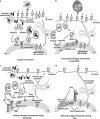The interplay between endoplasmic reticulum stress and inflammation
- PMID: 22249202
- PMCID: PMC7165805
- DOI: 10.1038/icb.2011.112
The interplay between endoplasmic reticulum stress and inflammation
Abstract
Endoplasmic reticulum (ER) stress may be both a trigger and consequence of chronic inflammation. Chronic inflammation is often associated with diseases that arise because of primary misfolding mutations and ER stress. Similarly, ER stress and activation of the unfolded protein response (UPR) is a feature of many chronic inflammatory and autoimmune diseases. In this review, we describe how protein misfolding and the UPR trigger inflammation, how environmental ER stressors affect antigen presenting cells and immune effector cells, and present evidence that inflammatory factors exacerbate protein misfolding and ER stress. Examples from both animal models of disease and human diseases are used to illustrate the complex interactions between ER stress and inflammation, and opportunities for therapeutic targeting are discussed. Finally, recommendations are made for future research with respect to the interaction of ER stress and inflammation.
Figures




References
-
- Matus S, Glimcher LH, Hetz C. Protein folding stress in neurodegenerative diseases: a glimpse into the ER. Curr Opin Cell Biol 2011; 23: 239–252. - PubMed
-
- Mhaille AN, McQuaid S, Windebank A, Cunnea P, McMahon J, Samali A et al Increased expression of endoplasmic reticulum stress‐related signaling pathway molecules in multiple sclerosis lesions. J Neuropathol Exp Neurol 2008; 67: 200–211. - PubMed
-
- Hybiske K, Fu Z, Schwarzer C, Tseng J, Do J, Huang N et al Effects of cystic fibrosis transmembrane conductance regulator and DeltaF508CFTR on inflammatory response, ER stress, and Ca2+ of airway epithelia. Am J Physiol Lung Cell Mol Physiol 2007; 293: L1250–L1260. - PubMed
Publication types
MeSH terms
Substances
LinkOut - more resources
Full Text Sources
Other Literature Sources
Medical

